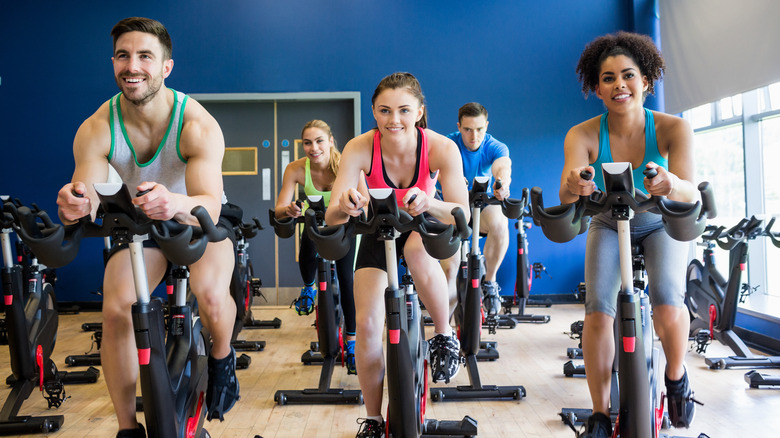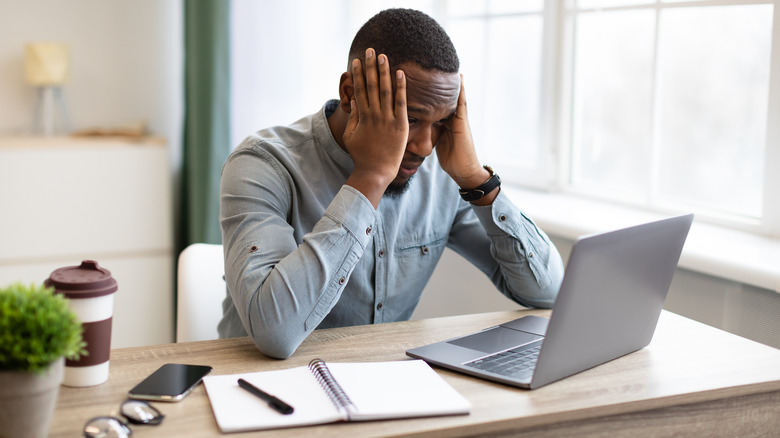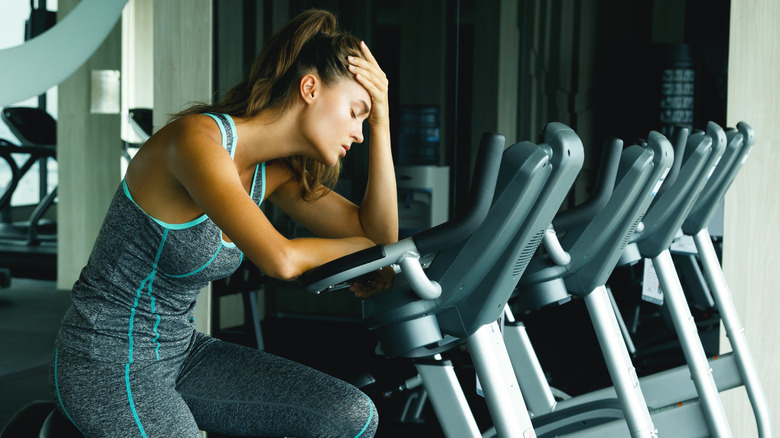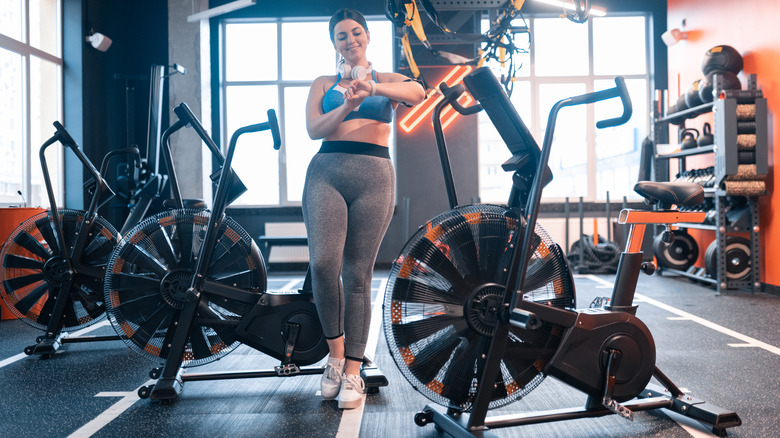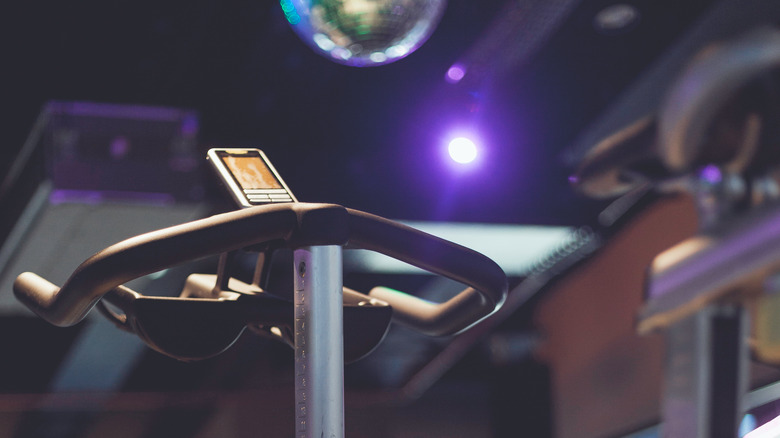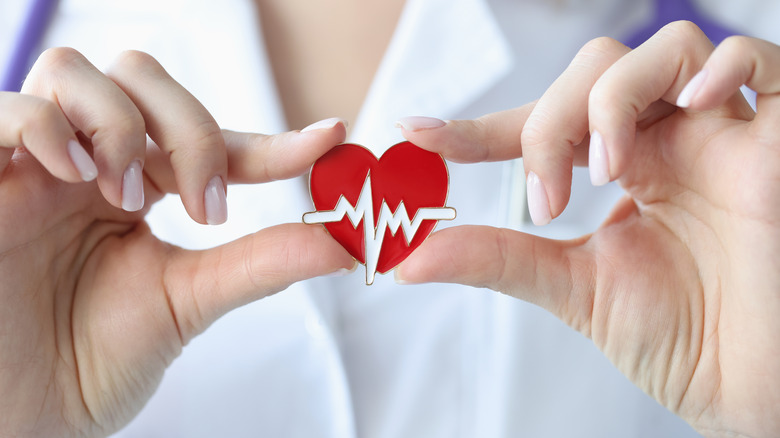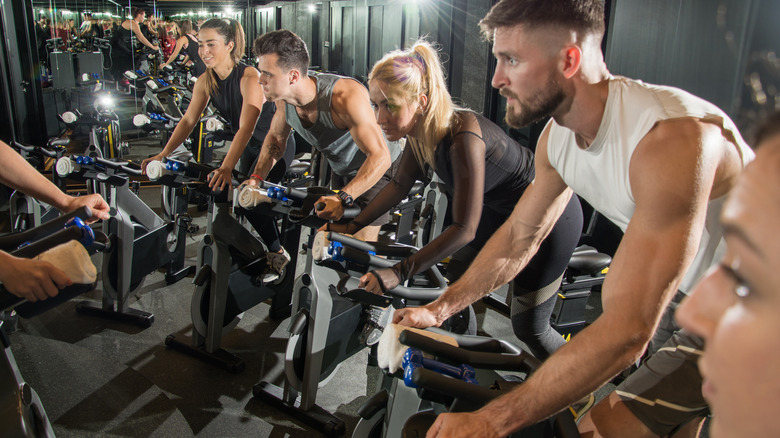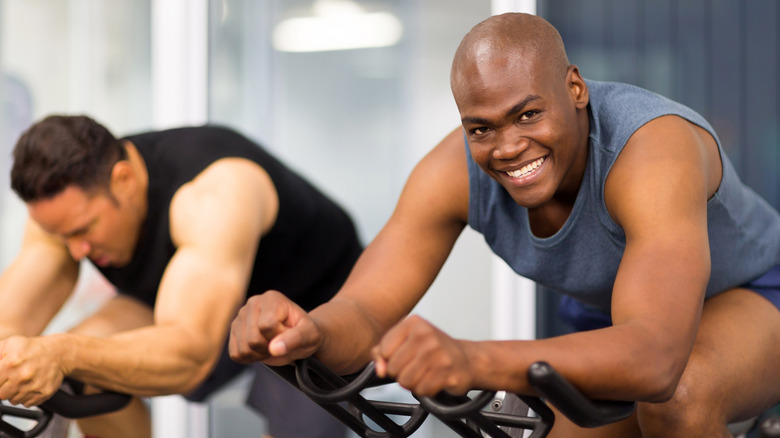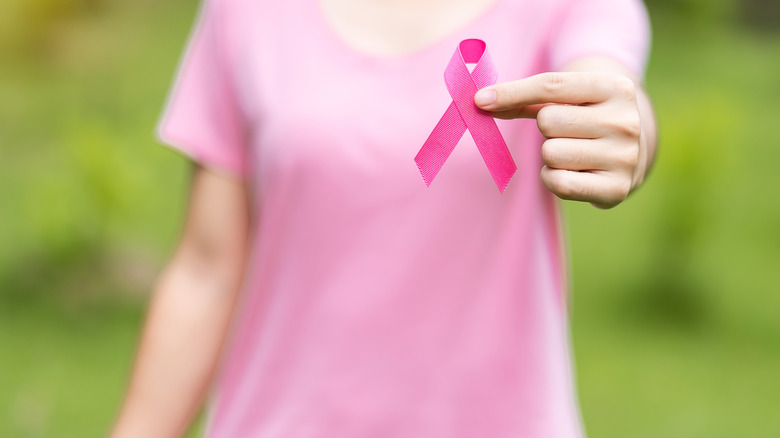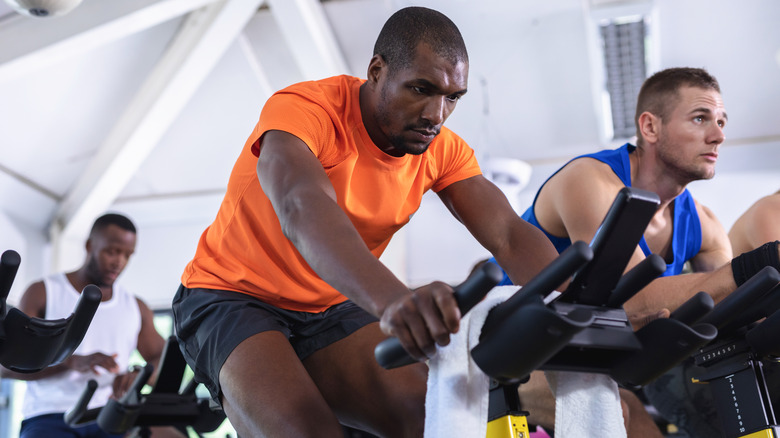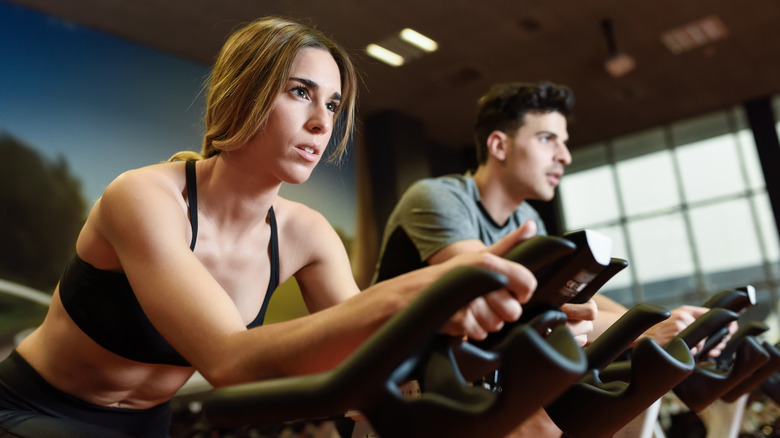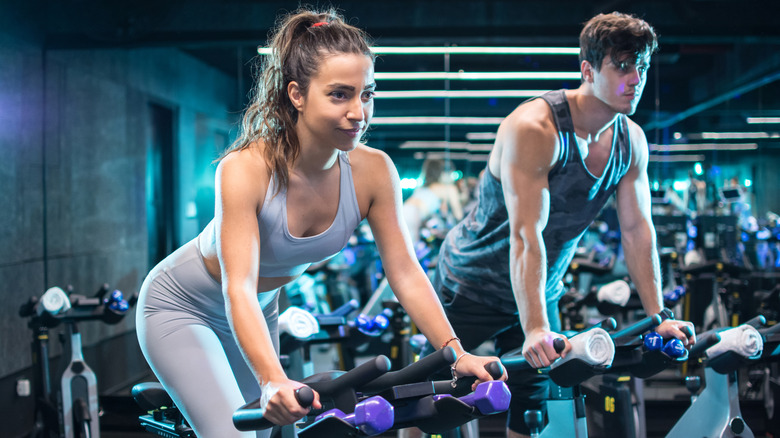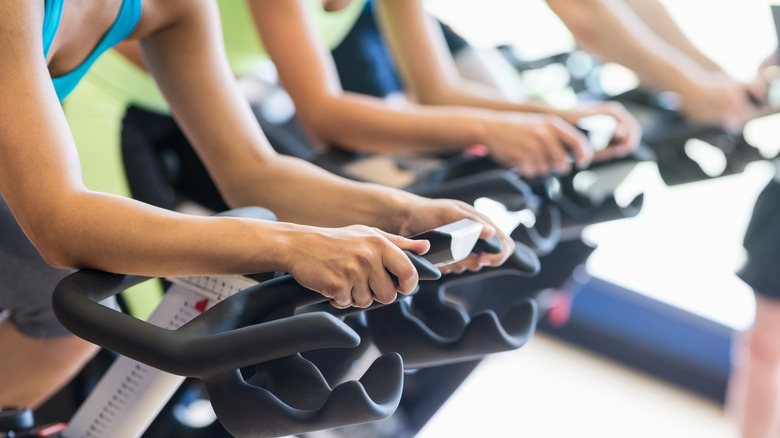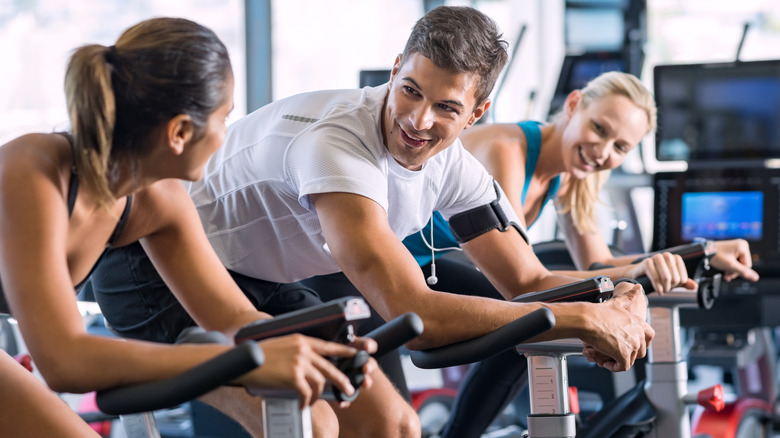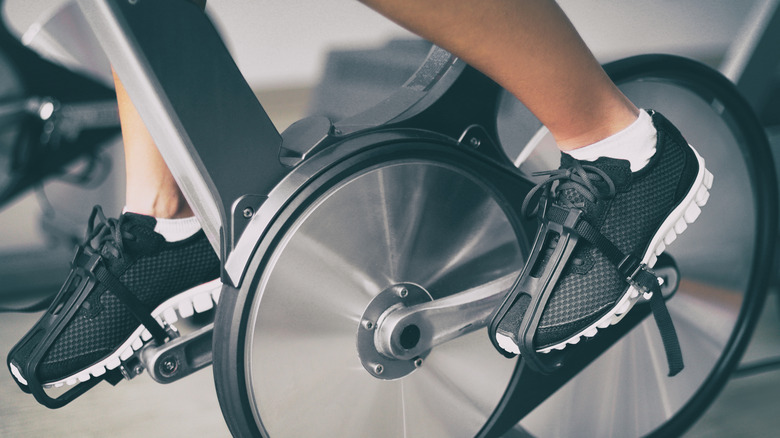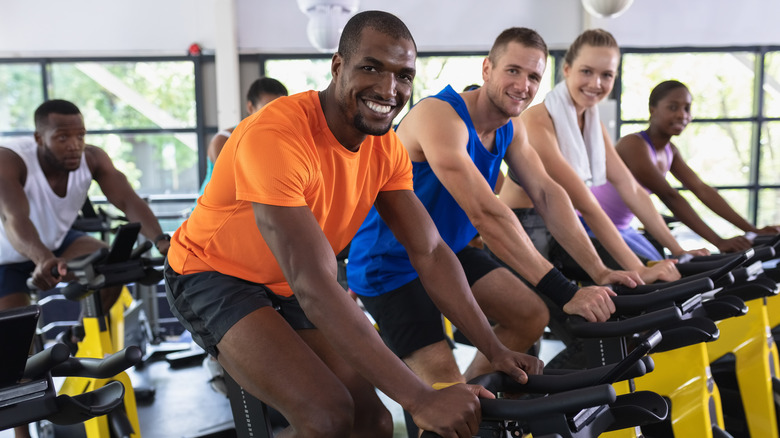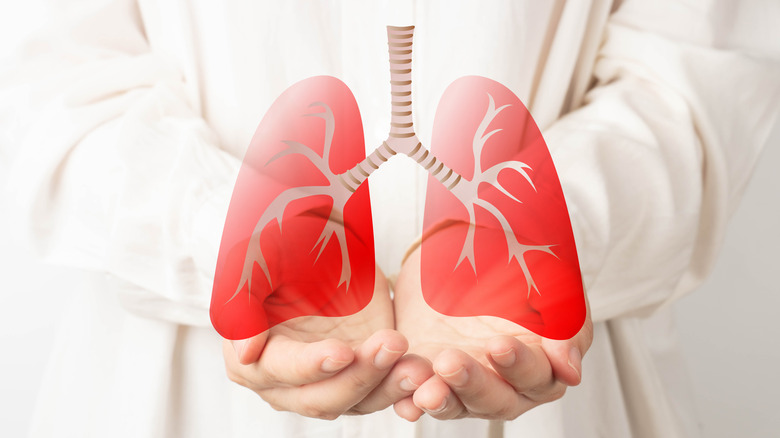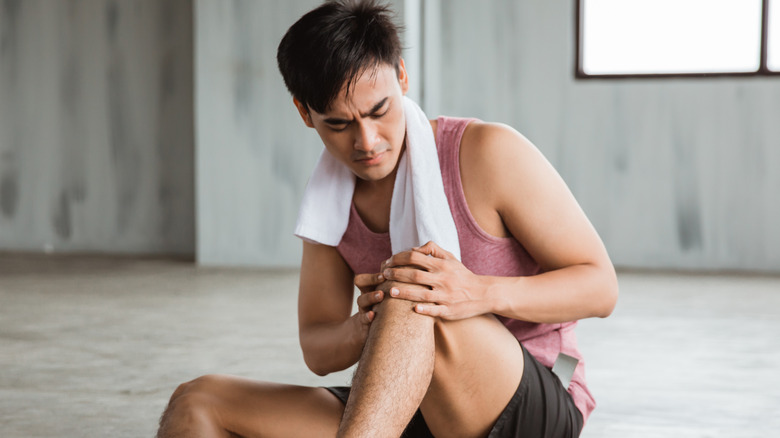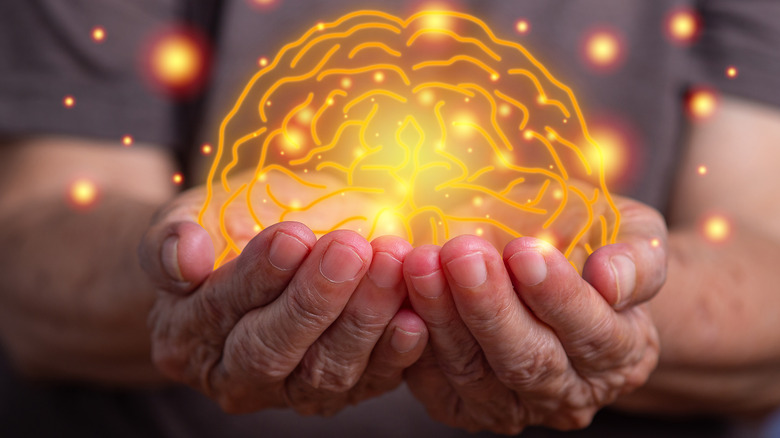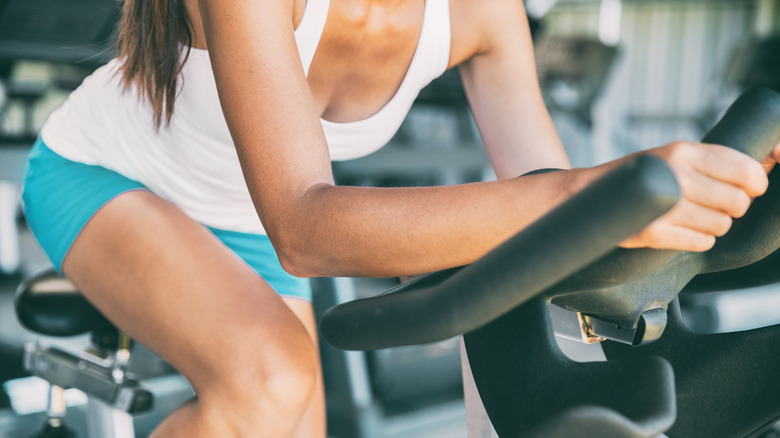What Happens To Your Body When You Take A Spin Class Every Day
Chances are you've at least heard of spin classes, even if you've never taken one. These group versions of indoor cycling have become increasingly popular ways to "feel the burn" while getting in some sweat-producing cardio. And part of their appeal is how they work out the three muscle groups in your legs.
As Verywell Fit explained, spin classes exercise your quadriceps or more commonly called quads, which are the muscles on the fronts of your thighs. Specifically, your quads are engaged as you push the bike pedals down. In addition, these muscles are essential during indoor cycling situations that simulate biking up natural inclines (via Healthline). Besides your quads, spinning also works out the muscles on the backs of your thighs (your hamstrings) since they do the opposite of your quads and are engaged when you turn the bike pedals up, Verywell Fit revealed. And while your quads and hamstrings are targeted during specific parts of cycling, your calf muscles in your lower legs are engaged for the entire rotation of the pedals (via Healthline).
In short, by exercising all these muscles, cycling can help your legs get toned. Of course, this is the most obvious benefit of spin classes, but there are less obvious ones, too — plus some possible health issues that you should be aware of before you sign up for this challenging workout. And, as always, you should speak with your health care professional before starting any new exercise.
You'll get rid of stress
No one wants to be stressed, but sometimes it's unavoidable. Maybe you're having a bad day at work where nothing seems to be going right. Or you're waiting to hear back from your doctor about a test result. Even something potentially positive like going on a first date can be nerve-wracking. But the good news is a spin class can help you deal with stress in several ways.
According to the Mayo Clinic, exercise can help your body produce more endorphins, which are a type of chemical in your brain that helps you feel good even in stressful situations. And, yes, exercise does physically stress your body, so you bet you'll be pumping out these chemicals as you're pumping your legs during spin class. Furthermore, exercise is a real mood booster and can increase your confidence and improve your sleep both of which will help tame your stress. Plus, working out forces you to concentrate on a single task, which can help you stop fixating for a little while on all the tensions in your life.
In addition, cycling puts your body through a stress fire drill in which your different systems learn to work together better as you become taxed from exercising (via Mayo Clinic). The results are you're physically more prepared for dealing with real stressful situations.
You may give yourself a headache
Even if you take a beginners' spin class, you are going to sweat. And if you do not bring enough water or an electrolyte drink along for the "ride," then there's an excellent chance you will become dehydrated, which can trigger a headache. Now, there's tiny bit of good news here. According to WebMD, dehydration happens in stages, and a headache is a symptom of moderate dehydration rather than severe dehydration, which requires emergency medical treatment. Unfortunately, however, letting your fluids drop too low is not the only reason why spinning can leave your head throbbing.
As WebMD revealed, activities like spin classes increase your circulation, which, of course, has its benefits. However, this additional blood flow also causes your blood vessels to dilate, which can trigger an exertional headache. And even though these types of headaches are usually harmless, WebMD recommends having a doctor check you just to make sure there's nothing more serious causing them.
The bottom line: Even though there are many tricks to get rid of a headache, you should never shrug them off as just a natural part of working out or starting a new exercise routine (via WebMD). Remember, pain is your body alerting you to a potential problem, whether it's that you need water or medical attention.
You'll improve your heart health
There's no doubt that when you take a spin class, you're going to feel your heart pumping. And that's a very good thing. According to the American College of Sports Medicine and the American Heart Association, biking is a form of aerobic exercise that can help protect your heart from future and current health issues (via Johns Hopkins Medicine). In addition, one study found people who cycle are less likely to have problems with their heart (including heart attacks) than people who don't cycle (via The University of Pittsburgh Medical Center).
So, taking a spin class can be good for your heart, but why exactly? Well, Dr. Kerry Stewart, director of clinical and research exercise physiology at Johns Hopkins Bayview, told Johns Hopkins Medicine, "One of the key benefits of exercise is that it helps to control or modify many of the risk factors for heart disease." These include lowering stress hormones and blood pressure, managing weight, raising what's known as "good" cholesterol, reducing the chances of developing diabetes, and lessening inflammation in the body. In addition, as you exercise, your muscles become more efficient at drawing oxygen from your blood, which prevents taxing your heart.
Of course, even doing something that is supposed to be good for you the wrong way can make it detrimental to your health. The University of Pittsburgh Medical Center recommends only increasing how long you cycle and the intensity of your cycling in slow increments and under the supervision of a doctor.
You could damage your hearing
Spin classes are known for their pulse-pounding music that makes your workout more fun while also keeping you motivated. However, there is a downside to rocking out while working out. As physician Roshini Rajapaksa wrote in Health, "Adults can tolerate 94 decibels for only one hour before it becomes potentially damaging to their hearing. And the music in some workout classes these days is blasted as loud as 99 decibels, a recent study found."
Okay, so maybe your ears will ring a little after spin class. It'll pass, right? Well, according to Dr. Rajapaksa, that buzzing or ringing is called tinnitus. One of this condition's main causes is loud sounds that can damage the nerves and tiny hairs inside your ears, both of which are crucial to your hearing (via Mayo Clinic).
In all likelihood, you can't ask your spin class' instructor to turn down the music. But there are some simple solutions to avoid hearing problems. Dr. Rajapaksa recommends bringing a pair of earplugs to class. While they won't completely block out the music — which is good since the music helps you with your spinning — they will muffle the sounds enough to protect your hearing. You can ask the venue of your spin class if they provide earplugs.
You'll lower your blood pressure
Unfortunately, hypertension (high blood pressure) is an all-too-common ailment for many adults. However, spin classes might not only help keep your blood pressure down but could even reduce your need for medication to manage it, according to the Mayo Clinic.
Exercise strengthens your heart so it can pump blood through your body more easily (via Mayo Clinic). This means your arteries are under less stress, which translates to lower blood pressure. Since biking gets your heart pumping faster and increases your breathing, the Mayo Clinic categorizes it as an aerobic activity, and asserts, "A combination of aerobic and weight (resistance) training seems to provide the most heart-healthy benefits." Plus, exercise can help with weight management, and losing just 5 pounds can make a difference when it comes to blood pressure. And if you tend to sit more often than you stand (like if you have a desk job), that lack of movement can also contribute to high blood pressure. Of course, sitting on a bike during spin class has the opposite effect.
Although exercise like cycling can help you lower your blood pressure, it's not going to happen overnight. As the Mayo Clinic explained, it will probably take roughly three months before you start seeing an impact, and if you stop the exercise, then your blood pressure will go up again.
You could experience blood pooling
This sounds like something from a horror movie, but don't worry. This has nothing to do with a certain hockey mask-wearing killer from Crystal Lake or an infamous creepy clown with red balloons. Nevertheless, you need to be aware of this medical condition — especially if you're taking spin classes or doing any other vigorous exercise.
As Verywell Fit explained, blood pooling happens when your heart rate goes down too quickly after a workout. This can cause orthostatic hypotension, which is low blood pressure that can occur when you stand up after, for example, sitting on a spinning bike (via Mayo Clinic). The body typically speeds up the heart to get blood circulating normally, but in the case of orthostatic hypotension, the body doesn't do that. Instead, blood pressure drops. As a result, you may have fuzzy vision, as well as become dizzy and faint.
If you experience blood pooling after a spin class, it might be because your blood sugar has dipped too low or you're dehydrated (via Verywell Fit). Try drinking water or an electrolyte drink or eating a post-workout snack and see how you feel. Also, get off your spin bike slowly to decrease the chances of falling from blood pooling. And don't be afraid or embarrassed to alert your instructor or even your fellow spinners if you need help.
You'll burn calories
How many calories can you burn during a spin class? It's complicated. There are quite a few factors that contribute to how many calories you can burn, and they go beyond how hard you work out (via Verywell Fit).
While your current weight is an important part of how many calories you burn when you exercise, so is your height, as well as your sex, your age, and the amount of muscle mass you have. In addition, even if you really push yourself while cycling, you still might not burn as many calories if you don't maintain the right form. Verywell Fit explained that "leaning too heavily on your bike can diminish calorie burn" since that can reduce how much your muscles are involved in the exercise.
With all that said, the publication estimates a spin class can burn anywhere from 400 to 600 calories, and some classes may advertise that they can help you burn even more. But if you want a more accurate and personalized reading, you should try using a calorie burn calculator or a fitness tracker. And if you're concerned that your form isn't correct and impacting your workout, you can always ask your instructor for assistance.
You might get acne
So you've finished a particularly tough spin class and you're a sweaty mess when you get off your bike. As you gather your gear and head towards the showers, someone in your class strikes up a conversation. Unfortunately, you may have just set yourself up for a breakout.
The Dermatology & Hair Restoration Specialists revealed that many of their patients notice their acne gets worse after a tough workout. The reason? All that sweat from exercising creates the perfect environment for pores to get clogged and pimples to form. Not exactly a shocker; however, Dr. Ben Behnam says you should start cleaning up by washing your face or showering "within a minute after finishing exercising." Yes, that sweat can ruin your complexion that fast!
And don't forget, acne doesn't just happen on your face. It also occurs on your chest and back, and according to the Dermatology & Hair Restoration Specialists, back acne is tough to treat. Banishing those blemishes may require antibiotic washes and topical treatments, as well as oral antibiotics. With all that said, if you do get a breakout, keep in mind that acne is an extremely common skin issue that affects millions in the U.S. alone. So if you feel self-conscious about it, just remember you're far from alone.
You'll reduce your risk of some cancers
Let's clear something up. The idea that a person is overweight or obese because they aren't dieting and exercising enough is a myth. There can be many factors outside of these two things that can cause additional weight gain. As such, spin classes may not be the magic key to losing weight. However, depending on the individual, cycling can assist with weight management, which can help reduce the risk of some cancers.
The University of Texas MD Anderson Cancer Center explained that being overweight could make someone more likely to develop cancers of the colon and the rectum. In addition, women who are overweight and have gone through menopause are more likely to get a form of breast cancer. And weight in particular on the waistline can increase your chances of developing not just these types of cancers but also uterine and pancreatic cancers (via MD Anderson Cancer Center). "It's not just fat directly under the skin," cautioned Sally Scroggs, a health education manager. "A wide waist also is a warning sign that fat may be growing around important organs, like the pancreas."
Since cycling burns calories, it can help a person manage their weight, which it turn can help to reduce the chances of developing these cancers. "The more you are active," explained Whittney Thoman, a senior exercise physiologist, "the more you decrease your risk for chronic diseases, including cancer."
You might damage your kidneys
Although you may love your spin classes, you shouldn't attend one daily. One study on athletes noted, "If indoor cycling were used as an everyday training activity, it is possible that the overall intensity would be too high and possibly contribute to developing nonfunctional overreaching" (via Time). In other words, that much daily training can become counterproductive. And the news doesn't get better for non-athletes and their kidneys.
Dr. Maureen Brogan cautioned when speaking to Time magazine that health issues from overexertion during spin class are very likely since it's possible to sweat away up to a liter of water if you spin for an hour. She explained that taking painkillers for sore post-workout muscles can hurt your kidneys. In addition, she said her findings show possible connections between taking a spin class and developing a condition known as rhabdomyolysis, which is when your muscles release proteins that can be toxic for your kidneys.
And if that's not enough to be concerning, you might not immediately realize something is wrong with your kidneys since, as Dr. Brogan explained, health issues involving these vital organs can set in a couple of days after your spin workout. Avoid overdoing it, make sure you stay hydrated, and talk with your health care professional about kidney-safe alternatives for dealing with muscle pain.
You'll decrease your chances of developing Type 2 diabetes
First, since there is more than one kind of diabetes, let's make sure we're on the same page. Type 2 diabetes is when your body produces insulin but does not use it properly (via Medical News Today). Having it can make you more likely to develop health issues with your kidneys and heart, as well as eyesight problems. But since lifestyle seems to play a role in whether or not you become a Type 2 diabetic, that spin class might help cut down your chances of developing this disease.
A study of 50,000 men and women found that people who either cycled or rode a bike were more likely to avoid developing Type 2 diabetes (via WebMD). In fact, the more they pumped those pedals, the more their risk of the chronic disease went down. And the news gets better. The study's participants were evaluated five years later, and again a connection was found between those who regularly cycled and a lower risk of Type 2 diabetes. In fact, they had cut their chances of developing this disease by 20%.
To be fair, the study acknowledges that while they did take into consideration other possible contributing factors for developing Type 2 diabetes such as alcohol and smoking, it could not establish a definitive link between cycling and the absence of this form of diabetes (via WebMD). Nevertheless, the research does demonstrate how a spin class may have another possible health benefit.
You may get saddle sores
Yes, you don't need a horse or a saddle to experience those unpleasant bumps on some sensitive areas of your body (aka your groin and thighs), explained the Cleveland Clinic. But even though this can be a side effect of taking a spin class, there is something you can do about it.
As Dr. Michael Schaefer noted on the Cleveland Clinic's website, there are three contributing factors that create the perfect storm for saddle sores. First is the friction of your skin rubbing against your clothes. Second is the moisture caused by your sweating during the workout. And third is the pressure of your body against the spin bike's seat. Fortunately, as Dr. Schaefer revealed, wearing bike shorts made from a breathable fabric and contain a type of padding called a chamois should cut down on your saddle sores. And, of course, wearing clean shorts for your workout and changing out of them as soon as you're done is a great way to keep those painful red bumps from forming.
Besides the right clothes, Dr. Schaefer recommends adjusting your bike's seat since how you distribute your weight during spin class can cause saddle sores. Spin-class bikes usually allow you to adjust them. It may take a little trial and error to get the seat just right, so you'll want to show up early for class. And if you're having any difficulty, ask your instructor for help.
You'll work your core
Spinning is definitely great for your legs, but it can be good for your core too. Remember, your core is made up of a number of muscles, including your abs, obliques (on the sides of your torso), and your lumbar and erector muscles, which support your back and spine (via Medical News Today). While your legs are automatically involved when cycling, you'll need to remember to engage your core during spin class.
So, how do you do this? Well, according to Women's Health, you want to make sure you set the resistance on your bike appropriately. You can tell by how much your hips are bouncing as you ride. By setting the right amount of resistance, you will engage your core and your glutes. You also want to maintain good posture on the spin bike, which will keep your core engaged and help with lower back pain.
If you're really looking to strengthen rather than just engage your core muscles, Women's Health recommends pairing a spin class with other core exercises like planking and single leg crunches. Additionally, Medical News Today recommends abdominal crunches for working your core muscles. Plus, as your core becomes stronger, you'll be able to maintain your balance better, and your spinning will be more stable as a result.
You're not going to work out your arms
Obviously, spin classes put the focus on your legs and lower body, but according to Verywell Fit, some are starting to add upper body exercises like using hand weights to their offerings. While this might sound like an easy way to incorporate more exercise into one class, there are drawbacks.
Posture is very important when taking a spin class. In fact, there can be challenges to getting your posture right. For example, if you're new to exercising, then you might be tempted to lean forward on the bike. Now, imagine adding weights. This can not only throw off posture but possibly cause injuries. In addition, if you want to build real muscle mass rather than just slightly toned muscles, Verywell Fit explained that you'll need heavier weights than the traditional 1- to 5-pound ones used in these types of cycling classes.
What can you do to get a good arm workout if you love spinning? Verywell Fit recommends a fusion class, in which part of the time is spent cycling and the other part is something entirely different that doesn't involve the bikes at all, like Pilates or yoga. You can also take a regular spin class and then do arm exercises like planks or weight training on your own.
Camaraderie will have a positive psychological impact on your brain
Generally speaking, people who go to a gym can be categorized into two camps: those who mostly exercise alone and those who mainly work out with others. Now, there's nothing wrong with going solo, but group activities like spin classes can offer unique benefits.
As Michael Yabut, training manager and national trainer at TITLE Boxing Club International, LLC, told NBC News, "For most people, it's difficult to stay consistent with workout routines, but having a certain group there waiting for you provides you with the motivation and accountability everyone needs to be successful." For example, if you usually run alone on a treadmill, and you decide one day to skip that workout, the treadmill isn't going to miss you. Skip a spin class, however, and your classmates might notice you're absent. After all, as Davina Wong, master trainer at Club Pilates, told NBC News, "The people you see each week in a group class eventually become your family and want to see you back each week creating accountability." In other words, the group dynamic of a spin class can help you stay motivated even when the workout is challenging.
And speaking of challenging, spin classes can also give you an encouraging support network. "All those shouts to do one more, or push to the finish line, plus the high fives and pats on the back for completing sets and accomplishing personal bests create amazing positive feedback loops," John Ford, certified exercise physiologist, told NBC News.
Your competitive nature could cause injury
Although exercising with others can help keep you motivated and encouraged to meet your fitness goals, it also can be a double-edged sword. Group activities like spin classes can bring out one's competitive side. Now, let's be clear: Healthy levels of competition can be good. But they also can have their potential pitfalls.
As Verywell Fit points out, constantly pushing yourself to be the top of the spin leaderboard can increase the chances of injuring yourself. This is because you could try to push yourself too far beyond your limitations both in terms of how high you set your spin bike's resistance and how fast you're pedaling. Even if you're not fixated on a leaderboard, just observing how fast your classmates are cycling, for example, could be enough to push yourself too hard without even realizing it.
Besides possible physical injury, the competitiveness that group classes like spin classes can bring out in some people could have a negative psychological impact (via Verywell Fit). Remember, competing with others involves comparing yourself to others. In a spin class, you'll probably compare your leaderboard score to your classmates' scores. And while trying to be the top score might motivate you, it can also cause burnout, which can affect your life outside the gym. In fact, The American Council on Exercise warns that burnout can zap your energy, disrupt your sleep, affect the quality of your work, and leave you feeling depressed.
Inspiring music will build endurance
While the loud music that you might find at a spin class can be taxing on your ears (especially if you don't wear protective earplugs), music can be beneficial when you work out. Besides, great tunes can make an activity more fun, Healthline explains, and there have been studies to support how much music can benefit a workout routine like spinning.
For example, a study in Medicine & Science in Sports & Exercise reports that music had a definite impact on people who cycled. The study's participants were asked to cycle at one speed without music and then at a faster, more challenging speed while listening to music. The results were the music made the harder workout feel less challenging and even comparable in terms of enjoyment level to cycling at the slower rate. And while there's still debate as to why music has this affect, one possibility is the music's tempo. A study in the Scandinavian Journal of Medicine & Science in Sports found that when 12 male participants cycled to different songs at different tempos, the faster songs led to better performance both in terms of speed and level of exertion. Essentially, "Jams can amp you up," according to Healthline.
Of course, there's a possible snag when it comes to spin classes and music. Unlike when you work out by yourself, you can't choose the music at a spin class. However, if there's a particular song you really like, you might want to suggest it to your instructor.
Healthier lungs
It's not unusual for one to feel winded because of exercise. But imagine if every time you worked out, you had real difficulty breathing. An article on Spoon University recounted a woman who, despite being athletic, found herself constantly coughing and having breathing issues whenever she exercised.
As the Spoon University article explained, the woman spoke with her allergist and learned that she had exercise-induced asthma. According to the Mayo Clinic, this condition is when vigorous exercise causes the airways to contract, making it harder to breathe. Also known as exercise-induced bronchoconstriction, its symptoms, which can include coughing and wheezing, are treatable with medication. Case in point, the woman in the article used an inhaler to manage her exercise-induced asthma. However, she didn't want her choices of exercise limited by needing the inhaler, so she explored other ways to help her condition and found that spin classes might improve her lungs' function.
Although she writes that the first class made her feel like her "lungs were going to explode," the woman's lungs did improve after attending spin class for a few months (via Spoon University). Specifically, she was having an easier time breathing even while working out. She attributes this to not just the vigorous nature of spinning but also that it's a very controlled form of exercise.
You might improve your PCOS
For anyone unfamiliar with this condition, polycystic ovary syndrome (PCOS) can cause a number of health problems — such as not ovulating properly and/or regularly, complications during pregnancy, elevated blood pressure and/or cholesterol, and sleep apnea, as Healthline notes. Of course, not every person who has PCOS will develop these conditions. But there are certain actions you can take to improve your odds of not experiencing these PCOS-related complications.
While it could take a combination of lifestyle changes to truly impact the possible negative effects of PCOS, the Androgen Excess & PCOS Society says exercise is an important part of a healthy PCOS regime (via Healthline). In particular the Society suggests working out every day for half an hour to get the maximum benefit. In addition, the type of exercise should be anywhere from moderate to higher intensity. And according to Healthline, aerobic exercises like spin classes are good choices for someone with PCOS to meet their physical activity needs.
So, why are exercises like spinning potentially so helpful when it comes to PCOS? Well (as stated above) PCOS can impact a woman's ovulation, which sometimes can cause infertility (via Healthline). But weight management and (depending on the individual) weight loss can help improve infertility caused by PCOS. Just remember, always work with a healthcare professional to design a weight-management plan that sets healthy goals and incorporates proper diet and exercise.
Your knees may hurt
As NYC-based Flywheel instructor Bobby McMullen explained to Well+Good, when you run, your feet keep striking the surface on which you're running, which "repeatedly introduces stress through your feet up into your knee joints with every stride." Therefore, one of the frequently stated benefits of stationary bike riding is that your feet are on pedals, creating less stress. That doesn't mean, however, that cycling can't impact your knees, especially if you don't adjust your bike properly.
According to Well+Good, cycling-related knee pain could be the result of having the bike's resistance set incorrectly. McMullen warns that "Hard impact at the bottom of the pedal stroke because of inadequate resistance is going to be hard on your knees." Also, McMullen cautions that your feet are clipped into place while cycling, and that if the rest of your body is moving all over the bike, that's a potential combination for knee pain. Going at high speeds while standing on a bike can also result in sore knees.
Additionally, setting the resistance too high can also cause knee pain. "If you're not able to hold 60 rpms with any given gear, you are putting too much load on your joints, specifically your knee, which will lead to injury," Garner Pilat, a cycling instructor at SWERVE, told Well+Good. Besides the resistance, not having the seat of the bike properly adjusted can also cause knee pain. For best results and to reduce your risk of injury, you should not set your seat too high, too low, or too far back for your body.
Your memory and cognition may improve
It's probably easy to notice how spin class benefits your muscle tone. However, spinning might also have a positive impact on something less obvious: your brain. Remember, spin class is a form of aerobic exercise, and researchers at the University of British Columbia found that aerobic workouts might make a part of the brain known as the hippocampus larger (via Harvard Health Publishing). And, yes, the hippocampus is important for activities like learning and verbal memory. Other areas of the brain that also might benefit from physical activity include the medial temporal cortex and the prefrontal cortex, both of which are needed for not just our memory but also thinking. Furthermore, exercise stimulates your brain to release chemicals that are crucial for your brain's cells and the development of blood vessels in your brain. Plus, exercise can lower inflammation throughout your body, as well as lower the chances of your cells becoming insulin resistant.
Besides these potential physical affects on the brain and body, exercise can be beneficial for getting a good night's sleep. And, of course, proper rest is vital for keeping your brain sharp. In addition, exercise can help with stress, anxiety, and mood in general, all of which can impact one's cognitive functions.
You may get tired
You might be thinking, "No kidding spin class can make you tired!" But there's a bit more to it than that. As Tim Bish, lead coach at Row House Chelsea in New York City, told Livestrong, "It is normal to feel a bit winded, slightly tired, or even mildly sore after, depending on the nature of the workout, but these symptoms shouldn't feel overwhelming or unmanageable." And certain common workout mistakes could make someone extremely tired to the point of feel fatigued. Common signs of unhealthy exhaustion can include headaches, nausea, and difficulty with activities like standing up after sitting in a chair.
For example, if you do an exercise like spin class and don't stay hydrated, that can lead to extreme exhaustion, according to Livestrong. You also don't want your blood sugar to drop too low during spin class, so it's important to have a healthy pre-workout snack. And even though a spin class instructor might encourage you to push yourself, don't overdo it. Remember, it's okay to start slow even if others in your class are crushing the leaderboard. At the end of the day, it's about progress, not placement. And with that in mind, you also want to avoid signing up for too many spin classes to avoid overtraining, which can also lead to exhaustion.
Your thighs may look thinner
As Dr. Michele Olson, professor of exercise science at Auburn University Montgomery, told Self, a person's muscles have endurance fibers and power/strength fibers. Aerobic exercises like the kind done in spin classes mainly target the endurance fibers, which unlike the power/strength fibers don't become bulky. In addition, Dr. Olson pointed out that "You have to lift heavy weights doing multiple sets to cause muscle growth in your power/strength fibers, and you don't use these to any appreciable degree during cardio exercise." With that said, celebrity trainer Tracy Anderson told Redbook that not combining spin class with other exercises could result in bulkier thighs. "Spin may burn calories in the short-term, but if that's all you're doing, it'll bulk your thighs," she explained. So, depending on your fitness goals, you may want to incorporate different types of exercises into your routine.
Additionally, if you take a spin class, don't become worried if you experience a slight and temporary increase in the size of your legs following this type of a workout (via Self). This change in leg size is due to factors like additional blood flow and higher levels of water storage in the muscles to offset water loss due to sweating. You should expect your legs' appearance to return to normal in about an hour.

